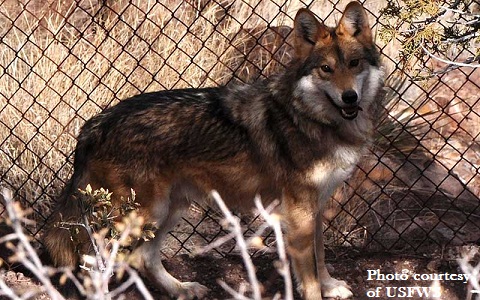16
Jul
In the News: Conservation groups ask for the release of more wolf packs

Twenty-five conservation groups are asking the U.S. Fish and Wildlife Service to release three more wolf packs into the Gila Wilderness in New Mexico this summer, the organizations said in a news release.
Infrequent releases from captivity and other reasons have led to “reduced diversity and led to genetic homogeneity,” the release said.
“The close relatedness” among the wolves has led to fewer pups born per litter, the groups said, noting that the population grew by just four between 2014 and 2017.
The New Mexico Cattle Growers Association and other groups will fight the proposal, Executive Director Caren Cowan said Thursday.
The release of Mexican gray wolves into the wild started in 1998 but has been mired in controversy and opposition from the Cattle Growers Association. In 2016, the Fish and Wildlife Service started using “cross-fostering,” or the release of captive-born pups into existing packs in the wild, but only 10 pups survived in 2016-17, the environmental organizations said.
The Fish and Wildlife Service disputed conservation groups’ claim on the effectiveness of cross-fostering.
“Initial results from the Mexican Wolf Recovery Program have demonstrated that cross-fostering can be successful in releasing captive wolves that survive to reproductive age,” the agency said in a statement.
The agency said it is “fully cognizant of the critical need to improve the gene diversity of the wild populations of Mexican wolves” and that strategies for releasing wolves from captivity may include the release of individual or paired adult wolves, the release of a pack or cross-fostering of pups.
“Mexican gray wolves are in a race with extinction and the clock is ticking,” Bryan Bird, Defenders of Wildlife’s Southwest Program director, said in a statement. “If we’re committed to saving this animal from extinction then the Fish and Wildlife Service needs to release more adult wolves into the wild and improve their genetic condition.”
Cowan disagreed. “To dump three packs in the wilderness on a whim right now doesn’t serve the wolf or anybody else,” he said.
In a letter to the Fish and Wildlife Service’s regional director, Amy Lueders, the groups said the reintroduction program was “successfully undertaken until abandoned under political pressure in 2007.”
The conservation organizations said scientists have criticized the Fish and Wildlife Service’s 2017 Mexican wolf recovery plan because they claim it’s insufficient to address inbreeding. The plan is being challenged in court.
The Mexican Wolf Interagency Field Team performed cross-fostering operations eight times in April and May of this year, and the team “will be evaluating release needs in 2018 and putting out a proposal later this year,” the agency said.
This article was published in the Santa Fe New Mexican
~~~~~~~
Show your support for Mexican wolves with a Letter to the Editor today!
The letters to the editor page is one of the most widely read, influential parts of the newspaper. One letter from you can reach thousands of people and will also likely be read by decision-makers. Tips for writing your letter are below, but please write in your own words, from your own experience. Don’t try to include all the talking points in your letter.
Letter Writing Tips & Talking Points
- Cross-fostering wolves is only one tool in the U.S. Fish and Wildlife Service’s toolbox and cannot be relied upon solely to save the Mexican gray wolf from extinction. Releases of captive adult wolves are desperately needed this year to save the species.
- The genetic crisis Mexican gray wolves are in is expected to result in lower pup survival rates, which we are now seeing. The only way to prevent the species from going extinct is to rapidly improve the genetics of the wild population by releasing adult wolves from captivity. Without releasing adults, the wild population could crash very quickly due to its small size and inbreeding.
- The U.S. Fish and Wildlife Service will not see the 10% annual population growth of Mexican gray wolves they claim they want to achieve with the methods they are employing. Their plan to recover the species without ever releasing an adult wolf to the wild again is preposterous and in bad faith.
- The U.S. Fish and Wildlife Service must get serious about curbing illegal killings of endangered Mexican gray wolves by increasing public acceptance of wolves, increasing penalties to dissuade wolf killers, and by accepting contemporary research on negative impacts of removing wolves who depredate.
- It has now been 40 years since the U.S. Fish and Wildlife Service first listed the Mexican gray wolf under the Endangered Species Act, yet the species is still struggling to remain viable.
- We have a moral, economic and scientific responsibility to restore endangered species like the Mexican gray wolf.
Make sure you:
“¢ Thank the paper for publishing the article
“¢ Submit your letter as soon as possible. The chance of your letter being published declines after a day or two since the article was published
“¢ Do not repeat any negative messages from the article, such as “so and so said that wolves kill too many cows, but”¦” Remember that those reading your letter will not be looking at the article it responds to, so this is an opportunity to get out positive messages about wolf recovery rather than to argue with the original article
“¢ Keep your letter brief, under 150 words
“¢ Include something about who you are and why you care: E.g. “I am a mother, outdoors person, teacher, business owner, scientific, religious, etc.”
“¢ Provide your name, address, phone number, and address. The paper won’t publish these, but they want to know you are who you say you are.
Submit your letter to the editor of the Santa Fe New Mexican



